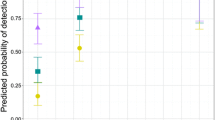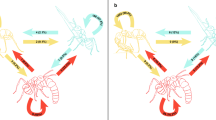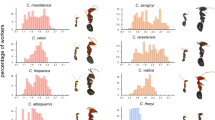Abstract
Division of labor was studied in colonies from Long Island and Florida populations of the fungus-gardening antTrachymyrmex septentrionalis. Workers showed age polyethism and a weak size polyethism, and these patterns of division of labor were not different in colonies from the two populations. Individual workers had repertoires comprised of three to five roles but tended to concentrate their labor within a single role. The data are consistent with the hypothesis that worker polymorphism and the elaboration of size-related behavior in the attine ants evolved along with the use of fresh vegetation as the fungal substrate. The data do not support the hypothesis that size variation in colonies ofT. septentrionalis evolved to promote efficient division of labor. Division of labor within the worker caste is based mainly on age and appears to be an attribute of the species rather than an adaptation to a particular habitat.
Similar content being viewed by others
References
Altmann, J. (1974). Observational study of behavior: Sampling methods.Behaviour 49: 227–267.
Beshers, S. N., and Traniello, J. F. A. (1994). The adaptiveness of worker demography in the weakly polymorphic attine antTrachymyrmex septentrionalis.Ecology 75(3): 763–775.
Brandão, C. R. F. (1978). Division of labor within the worker caste ofFormica perpilosa Wheeler (Hymenoptera: Formicidae).Psyche 85: 229–237.
Calabi, P., Traniello, J. F. A., and Werner, M. H. (1983). Age polyethism: Its occurrence in the antPheidole hortensis, and some general considerations.Psyche 90: 395–412.
Calabi, P., and Traniello, J. F. A. (1989a). Social organization in the antPheidole dentata: Physical and temporal castes lack ecological correlates.Behav. Ecol. Sociobiol. 24: 69–78.
Calabi, P., and Traniello, J. F. A. (1989b). Behavioral flexibility in age castes of the antPheidole dentata.J. Insect. Physiol. 2: 663–677.
Gordon, D. M. (1987). Group-level dynamics in harvester ants: Young colonies and the role of patrolling.Anim. Behav. 35: 833–843.
Hölldobler, B., and Wilson, E. O. (1990).The Ants, Belknap Press of Harvard University Press, Cambridge, MA.
Jaffe, K., and Villegas, G. (1985). On the communication systems of the fungus-growing antTrachymyrmex urichi.Insectes Soc. 32(3): 257–274.
Kolmes, S. A. (1985). An information theory analysis of task specialization among worker honey bees performing hive duties.Anim. Behav. 33: 181–187.
Lehner, P. N. (1979).Handbook of Ethological Methods, Garland Press, New York.
Lighton, J. R. B., Bartholomew, G. A., and Feener, D. H. (1987). Energetics of locomotion and load carriage and a model of the energy cost of foraging in the leaf-cutting antAtta colombica Guer.Physiol. Zool. 60(50): 524–537.
McDonald, P., and Topoff, H. (1985). Social regulation of behavioral development in the antNovomessor albisetosus (Mayr).J. Comp. Psych. 99(1): 3–14.
Oster, G. F., and Wilson, E. O. (1978).Caste and Ecology in the Social Insects, Princeton University Press, Princeton, NJ.
Rice, W. R. (1989). Analyzing tables of statistical tests.Evolution 43(1): 223–225.
Robinson, G. E. (1987). Regulation of honey bee age polyethism by juvenile hormone.Behav. Ecol. Sociobiol. 20: 329–338.
Robinson, G. E. (1992). Regulation of division of labor in social insect colonies.Annu. Rev. Entomol. 37: 637–665.
SAS Institute (1985).SAS User's Guide: Statistics, Version 5 ed., SAS Institute, Cary, NC.
Schmid-Hempel, P. (1992). Worker castes and adaptive demography.J. Evol. Biol. 5: 1–12.
Seeley, T. D. (1982). The adaptive significance of the age polyethism schedule in honeybees.Behav. Ecol. Sociobiol. 11: 287–293.
Seeley, T. D. (1985).Honeybee Ecology, Princeton University Press, Princeton, NJ.
Sokal, R. R., and Rohlf, F. J. (1981).Biometry, 2nd ed., W. H. Freeman, San Francisco.
Walker, J., and Stamps, J. (1986). A test of optimal caste ratio theory using the antCamponotus (Colobopsis) impressus.Ecology 67: 1052–1062.
Weber, N. A. (1972).Gardening Ants: The Attines, Proceedings of the American Philosophical Society, Philadelphia.
Wetterer, J. K. (1994). Nourishment and evolution in fungus-growing ants and their fungi. In Hunt, J. H., and Nalepa, C. A. (eds.),Nourishment and Evolution in Insect Societies, Westview Press, Boulder, CO, pp. 309–328.
Wheeler, D. E. (1991). The developmental basis of worker caste polymorphism in ants.Am. Nat. 138: 1218–1238.
Wheeler, D., and Nijhout, F. (1984). Soldier determination inPheidole bicarinata: Inhibition by adult soldiers.J. Insect Phys. 30: 127–135.
Wilson, E. O. (1968). The ergonomics of caste in the social insects.Am. Nat. 102: 41–66.
Wilson, E. O. (1971).The Insect Societies, Belknap Press of Harvard University Press, Cambridge, MA.
Wilson, E. O. (1976a). A social ethogram of the neotropical arboreal antZacryptocerus varians (Fr. Smith).Anim. Behav. 24: 354–363.
Wilson, E. O. (1976b). Behavioral discretization and the number of castes in an ant species.Behav. Ecol. Sociobiol. 1: 141–154.
Wilson, E. O. (1980a). Caste and division of labor in leaf-cutter ants (Hymenoptera: Formicidae:Atta). I. The overall pattern inA. sexdens.Behav. Ecol. Sociobiol. 7: 143–156.
Wilson, E. O. (1980b). Caste and division of labor in leaf-cutter ants (Hymenoptera: Formicidae:Atta). II. The ergonomic optimization of leaf-cutting.Behav. Ecol. Sociobiol. 7(2): 157–165.
Wilson, E. O. (1983a). Caste and division of labor in leaf-cutter ants (Hymenoptera: Formicidae:Atta). III. Ergonomic resiliency in foraging byA. cephalotes.Behav. Ecol. Sociobiol. 14: 47–54.
Wilson, E. O. (1983b). Caste and division of labor in leaf-cutter ants (Hymenoptera: Formicidae:Atta). IV. Colony ontogeny inA. cephalotes.Behav. Ecol. Sociobiol. 14: 47–54.
Wilson, E. O. (1984). The relation between castes and division of labor in the ant genusPheidole.Behav. Ecol. Sociobiol. 16: 89–98.
Author information
Authors and Affiliations
Rights and permissions
About this article
Cite this article
Beshers, S.N., Traniello, J.F.A. Polyethism and the adaptiveness of worker size variation in the attine antTrachymyrmex septentrionalis . J Insect Behav 9, 61–83 (1996). https://doi.org/10.1007/BF02213724
Revised:
Issue Date:
DOI: https://doi.org/10.1007/BF02213724




